Social Media Trends You Need To Watch In 2019
We outline the top social media trends to watch in 2019, from the rise of AI to the proliferation of ephemeral content (eg. Instagram stories). Developments not only in the platforms, but also in our devices and the way we use them are driving social media to new places this year. Find out now!
2019 is here and marketing on social media remains a super high reward for your time and effort, if you get it right.
More than four billion, or close to three quarters of the 5.5 billion adults on earth now have a smartphone. 42% of the world are on social media, and those platforms boil down to Facebook (including Instagram and WhatsApp), Twitter, Snapchat, and WeChat. Arguably, iMessage and even Fortnite are social networks - approximately 1 in 100 people are playing Fortnite.
As always, the platforms continue to weave changes both positive and less positive for marketers, consumer preferences evolves, and opportunities grow exponentially.
This leads to trends. You can fight the trend, but once a trend becomes the normal, and you’re not already in the game, it’s not going to be easy to get cut-through.
What’s a social media marketer to do? It’s worth considering the trends that you need to pay attention to in 2019. These are happening right now or they’re just over the horizon, and social media is where the biggest wins will play out.
Let’s take a look at the trends that will define 2019.
Video, video, video: Facebook, livestreams, and video ads
Facebook remains the default social network for so many users, who use the platform in different ways. The power of Facebook is of course no longer just friends, but Events, Groups, Marketplace, and perhaps even Dating. All continue to keep Facebook useful even as usage and habits change, and ensure people are engaged with what’s in their News Feed.
56% of internet users watch videos on a social platforms including Facebook, Twitter, Snapchat or Instagram each month, a number that has remained remarkably consistent in recent years:

Adding YouTube, which accounts for more than half of all social video views, boosts that number further.
51% of video is consumed on a mobile device, a number that is trending upwards as screen size has increased and both connectivity and data allowances improve.
Great video content continues to work, too: more than 60% of shoppers say online video has given them ideas and inspiration for their purchases. 69% of users would prefer to watch a video to learn about a product of service, while businesses that use online video see revenue grow 49 percent faster. Video is proven to drive conversion.
Video ads
Video remains king for ad impressions, too. 66.2% of ad impressions on Instagram were the result of video content, and we’re expecting that number to grow even further. Video ads have the highest click-through rate (CTR) of all digital ad formats.
Video ad impressions are steady, and no longer growing fiercely, but they’ve already won the war:

Expect that number to hold, or grow further, in 2019. In terms of the type of video ads, experiments continue. We’re certainly likely to see more ‘snack ads’, at under 10 seconds, with Facebook itself pushing advertisers to try six-second video ads.
Live video
Livestreams have grown across Facebook Live, YouTube Live, Twitch, and more. 28% of people engage with livestreams each month, with the three platforms capturing a majority of users. Facebook’s larger user base shows enduring growth, but not necessarily engagement hours:
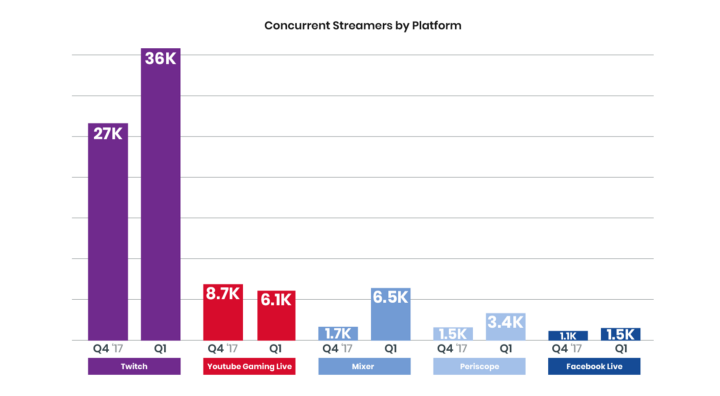
Twitch, owned by Amazon, and is completely focused on livestreaming, continues to add elements outside of its original niches as well, while YouTube Live is growing rapidly as well:
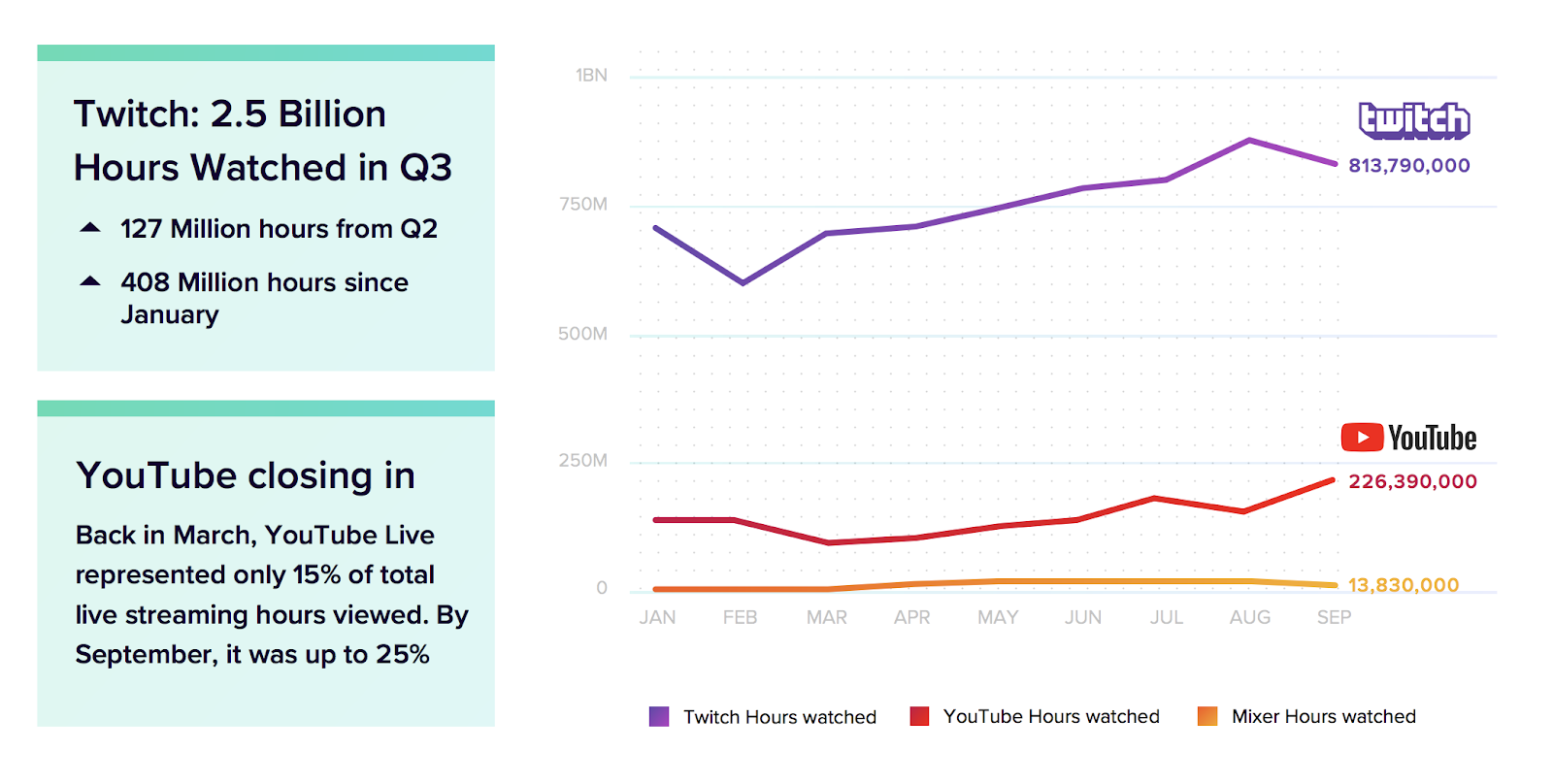
Twitch’s platform saw the breakout of the first mainstream gamer, Ninja, courtesy of his domination of the world’s most popular game, Fortnite, in 2018. Twitch remains a notoriously anti-marketing community, but streamers are influencers and the community supports streamers and their brands when the fit makes sense.
Brands have offered clever, genuine, and original broadcasts as well. Old Spice is just one example of a brand that’s figured out fun engagement on Twitch, live streaming an obstacle course game show called 'Foam Zone' in 2018.
Influencer marketing gets smarter & more focused
The days of smart brands sponsoring influencers with questionable numbers of followers are over. Savvy marketers are focusing on engaged influencer audiences and positioning their brand, products, and services, with natural fits that offer authenticity.

While Instagram is a hotbed for influencer marketing, YouTubers, Twitch streamers, newsletters, and podcasts offer popular ways to get products and new ideas in front of large, regular audiences from people and publishers they trust. The trend of trusting people we feel we know well from their lives shared with us via video, images, or audio will continue in 2019.
It’s no longer just major names either - micro- and nano-influencers that don’t attract huge followings in terms of straight metrics, but dominate a narrow market and come across as far more genuine than mega-influencers.
Compare the macro and micro impact: Those with 10 or more million followers had likes 1.6% of the time, and comments just 0.04% of the time, on Instagram. That compared with 8% and 0.5% respectively for nano-influencers with less than 1000 followers.
Plus, 70% of teenage YouTube users trust influencers more than traditional celebrities.
What is also clear is the shift away from simple open endorsement of products. Consumers are less receptive to unrelated or once-off brand plugs. Long-term deals, where a relationship is continued as a collaboration for a more organic relationship, are a newer trend for brands and influencers. Notably, this is not new for more traditional marketing, such as for sports brands and athletes - consider LeBron James’ lifetime deal with Nike. But this is a newer trend for smaller influencers, and delivers endorsements that come from genuine partnerships.
Simone Giertz of ‘Shitty Robots’ is a good example of a YouTuber working with relevant sponsors, including building a shitty robot for HBO’s Westworld, ahead of season two, with more than 500,000 views, and earned media.
Alignment is the other element that’s beating out bulk numbers. Working with an influencer that aligns closely with brand ethos and values create more successful influencer partnerships.
It works. In 2018, businesses made $7.65 for each $1 spent on influencer marketing, up from $6.50 for every $1 from a survey in 2015.
AI: Contextual assistance powers chatbots on social
Chatbots offered novelty and fun marketing options in previous years, but generally suffered some reputation problems when people asked real questions and received wrong or frustrating non-answers.

AI developments are showing that chatbots are now becoming useful. Well-oiled chatbots on a platform such as Facebook Messenger can deliver 24/7 one-to-one FAQ-based communication with customers, at very low cost, which can offer ongoing reputational benefits to increased conversions to cost savings, while improving customer satisfaction. And the truth is, customers are demanding a response, and fast. According to Twitter, over half of all users expect a response to customer service concerns within an hour, while another study shows that only 6 percent don’t expect an answer.
But chatbots can now go much further than this, too.
While true AI is still some years away, machine learning and natural language understanding have improved dramatically. This is allowing businesses to go beyond simple question and answers, and even develop AI assistants that can offer ways to upsell when customers need.
A case study of a telecommunications company offering an AI assistant to convert leads at low-cost shows one angle here:
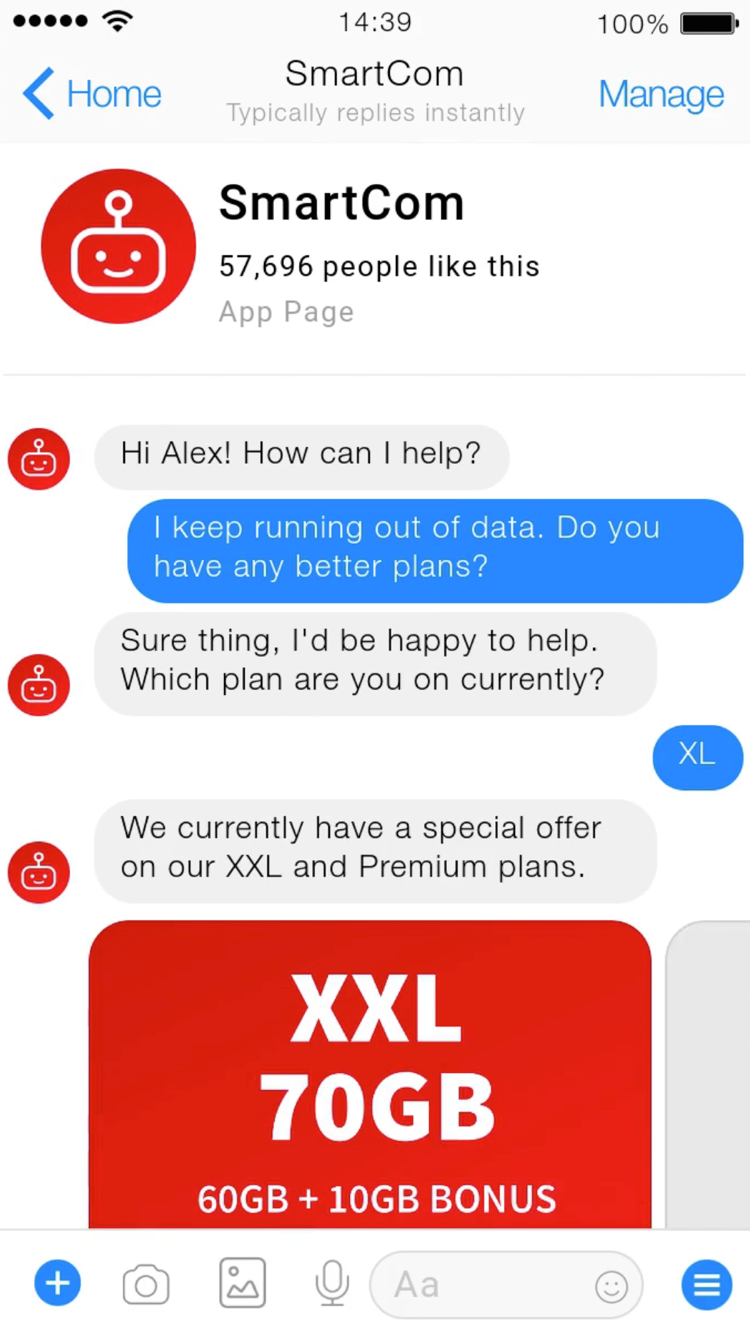
Thankfully, the world of chatbots is more accessible than ever and is not limited to paid options. While paid options exist, one of the better options comes from Rasa, which offers free, open-source AI assistant and chatbots with a large community base delivering regular improvements and ideas for developers.
- Fun and engaging real-world chatbot examples and more detail for chatbots ideas here.
Smart speakers, too
Both the uptake and capabilities of Google Home, Amazon Echo, and Apple HomePod devices continue at pace. The total number of devices ticked up by 78% year-on-year, while 52% of owners say they use their device daily or more.
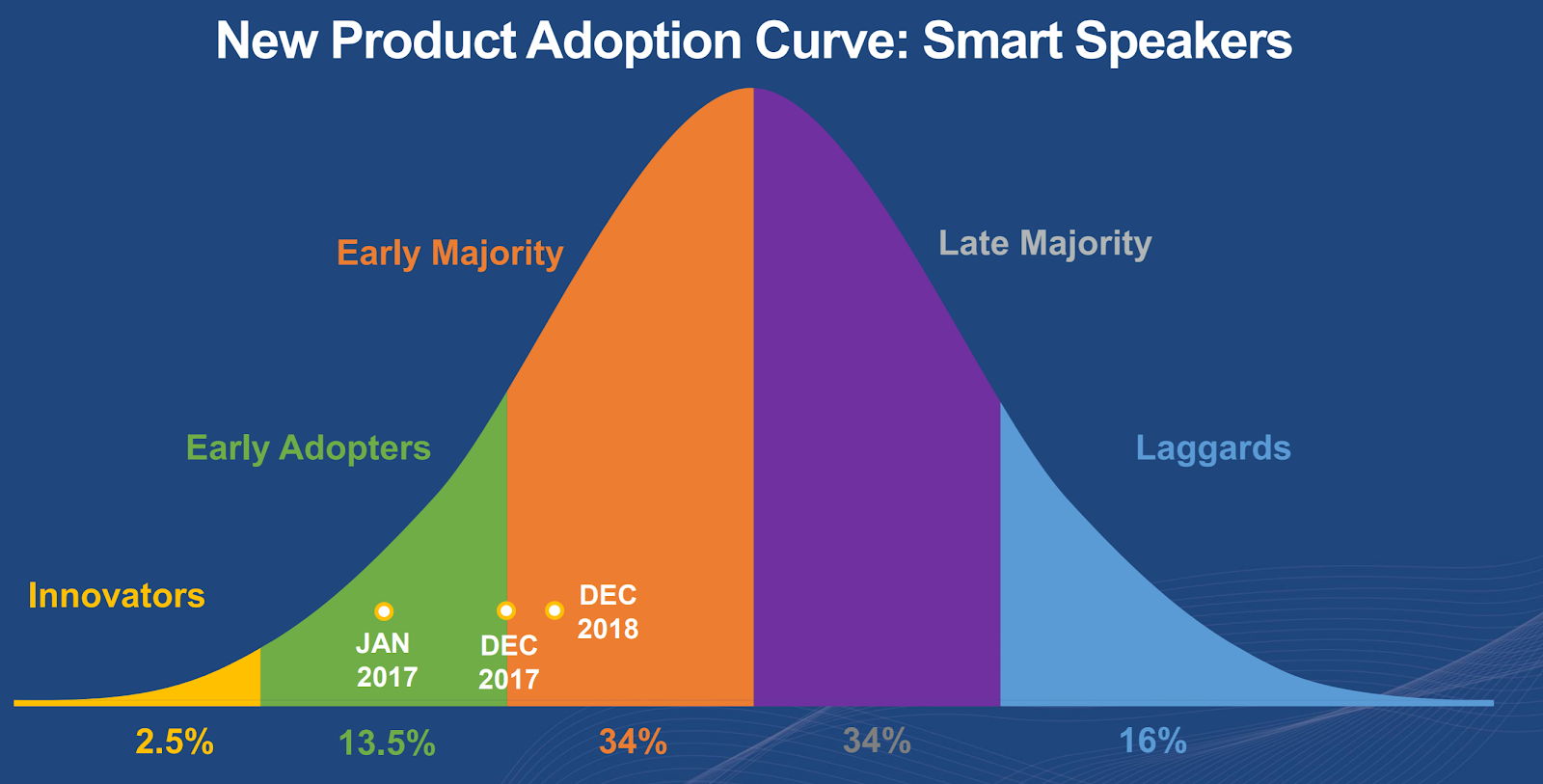
5G isn’t as impactful for these devices - more bandwidth will help these devices react faster and more seamlessly, but the opportunity is here already. More and more publications and creators are developing useful audio content for smart home devices, and it’s inevitable that these platforms will allow targeting marketing and ads.
For now, ensuring that your content ranks highly for SEO may see it surface when questions are asked to the Google Assistant, for example, which can add an additional marketing funnel for your product or service.
5G: A richer social web, VR/AR, and Gen Z
The upgrade of mobile networks and the release of 5G compatible smartphones across 2019 and beyond will have massive implications for media consumption. 2019 may not see huge take-up beyond early adopters, but major brands such as Samsung, Huawei, Xiaomi, and OnePlus, are set to offer 5G devices within the next three months.
5G allows for a significant increase in download and upload speeds, at very low latency.
ABI Research indicates that 5G will bring about a 10-fold improvement in throughput, a 10-fold decrease in latency, 100x improvement in bandwidth capacity, and network efficiency over 4G speeds. Obviously, if those figures are realised, this will be a step-change in bandwidth and speed.
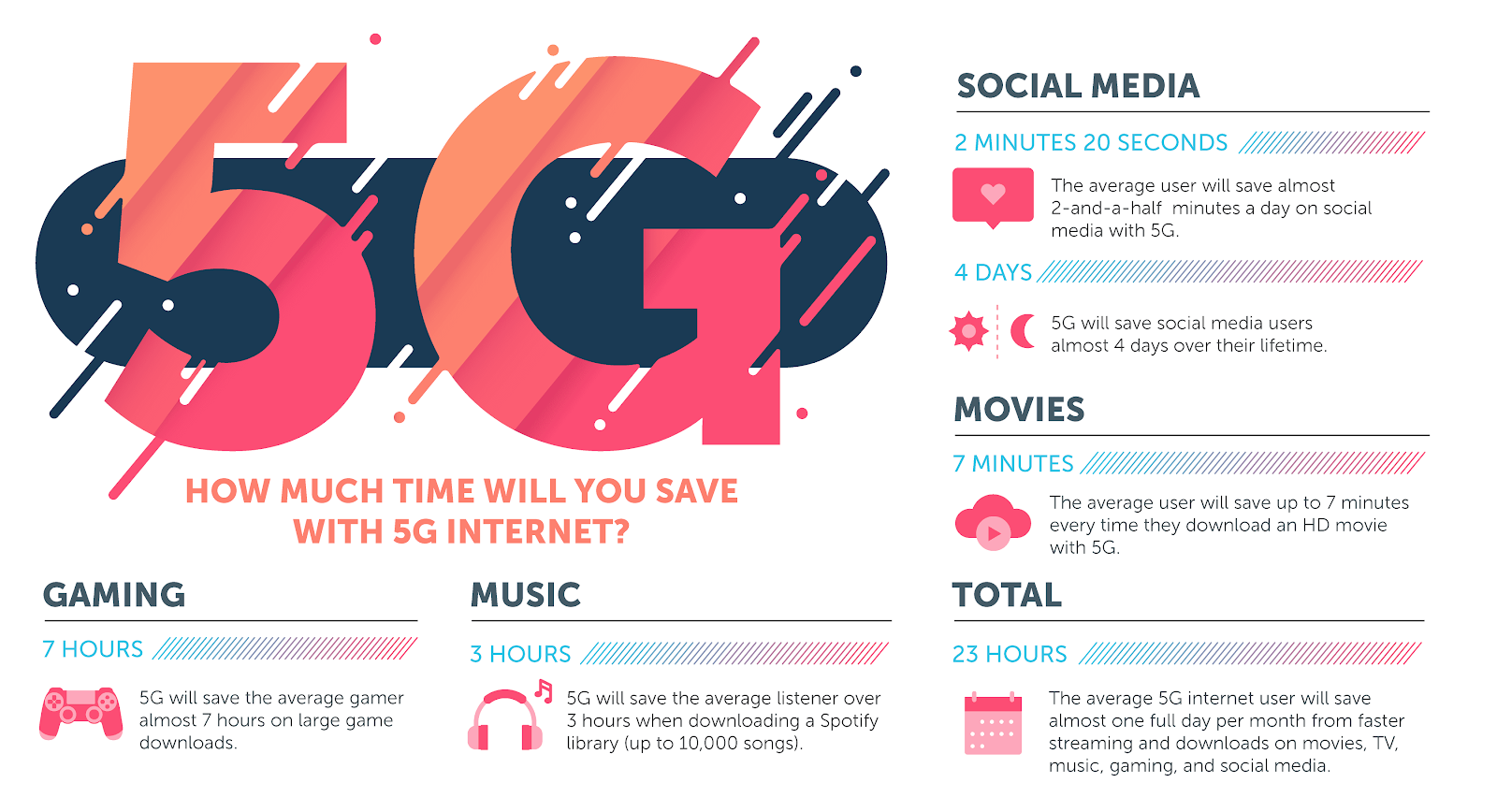
But what does that mean for social media trends? First, less time will be wasted browsing social media waiting for content to load, which leads to an increased consumption of even richer media in more engaging ways.
What’s more important though is that it allows for new interactions and experiences. The first applications are already appearing in gaming, sports, and video. 5G AR and VR experiences allow almost seamless productions, with no lag, which allows true immersion. Already the NFL has delivered live VR footage from helmets in-game, creating a feeling of being part of the game. Teams wearing VR headsets can play with physical balls, throwing and catching while wearing a headset, with 5G able to transmit data fast enough to make this entirely viable.
The lowest hanging fruit will be the promise of making online and social video while on the go both better and more enjoyable. But 5G will foreseeably make social VR and AR a viable reality as well, which will appeal to Generation Z who look set to drive adoption as the technologies mature. VR and AR are where Facebook’s efforts with Oculus continue, and 5G should enable next-level immersive and interactive experiences. Combined with Internet of Things sensors working in real-time, availability of data will grow for marketers as well.
5G will be the catalyst for innovation, and its possibilities will be demonstrated throughout the year. Like the rollout of 4G, it’s likely to be an imperfect release with networks already exaggerating their capabilities, but innovations are starting already.
Socially-engaged CEOs become the new normal
More than any other employee, the CEO in a business controls the message of the company and projects company culture outwards. Aside from private and personal news, CEOs that post company and business news and updates publicly and widely to social media, and do it well, offer tangible benefits. This may boost reputation, make the company more appealing to consumers and job applications, and develop new leads. Of course, CEOs can respond directly to customers and communicate their vision, and cut-through the world of fake news. Publicly communicating to employees and congratulating them are increasingly common as well for leaders already on social media.
LinkedIn holds the more of the cards here, with more CEOs using the business-oriented network in this way than any other platform. That makes sense when the average CEO has 930 connections on LinkedIn. But LinkedIn doesn’t offer appeal to younger audiences - just 13% of Millennials use the platform. That means while posting LinkedIn updates matter, the 88% of CEOs who are only using one platform aren’t getting their voice in front of a sufficiently wide audience.
There’s also a measurable difference between a CEO being present or visible on social media, and actually engaged, and posting:
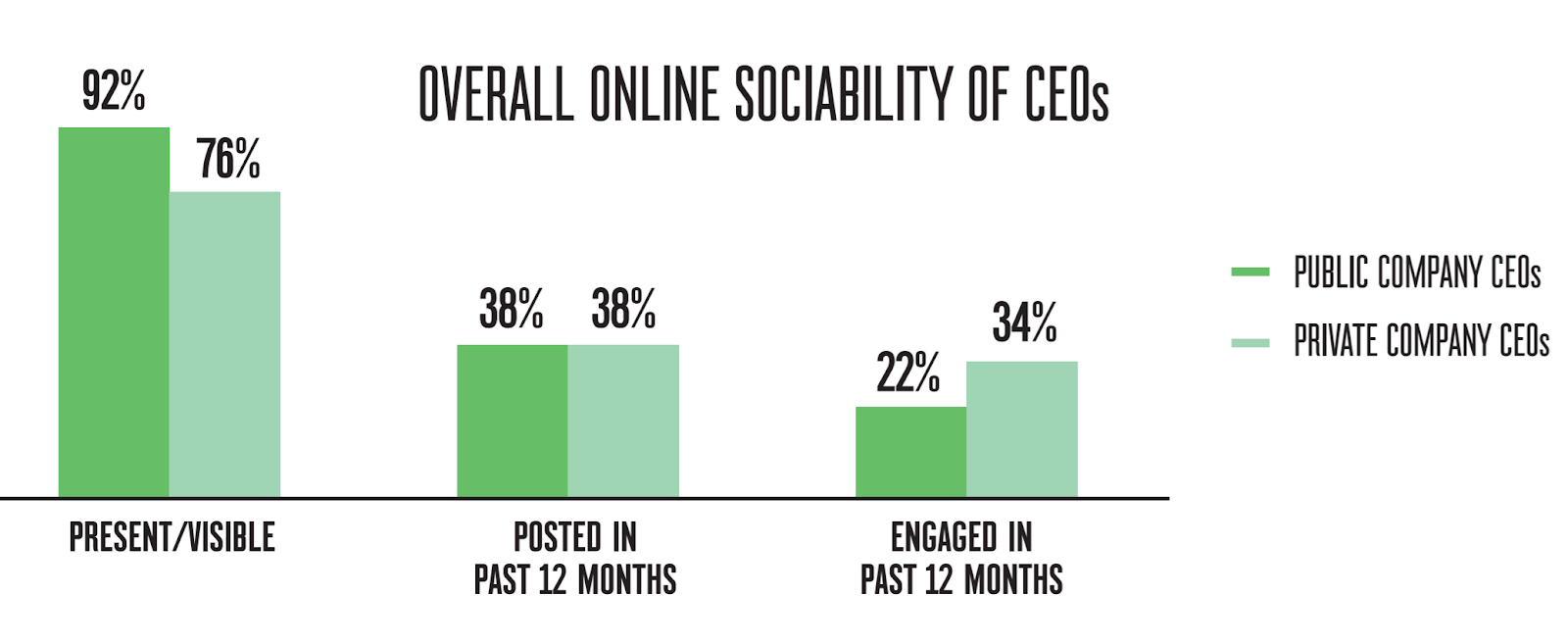
Real CGC - CEO-generated content - can offer authenticity that generates cut-through. Company blogs and Medium are a start, while both Instagram and Twitter offer platforms to deliver swift, personal and authentic content.
Content: Authenticity, Ephemeral Content, Social and Political issues.
We know that the overwhelming majority of consumers (86 percent) said authenticity is important when deciding what brands they support. Yet 57 percent of consumers think that less than half of brands create content that resonates as authentic. This has led to the growth in encouraging user-generated content or UGC, and showcasing that content.
The impact of UGC has only grown. Highlighting and placing customers in the spotlight is a kind of perpetual machine, generating more UGC, driving more brand awareness, which creates more UGC. And UGC does more work along the way: fan videos have been shown to get 10 times more views than branded content. Sometimes this skews further: 99% of views for Lego themed videos were attributed to user-generated content, while Apple gets 100x more views on YouTube from earned vs. owned media. It’s no coincidence that more than 64 percent of social media users actively seek out UGC, such as reviews, before making big purchasing decisions.
Promoting influencers that are endorsing your product, sharing reviews, actively curating UGC, encouraging customers to share their experiences, and working towards a community are all good steps along the way towards a strong UGC showing.
Another chance for authenticity is in ephemeral content, which is content that only exists for a certain period of time. This trend becomes the normal with Snapchat images and video, and was given fresh importance with Instagram’s introduction of Stories. Stories saw Instagram users and usage both rise, with people under 25 spending upwards of 32 minutes using Instagram according to the platform itself. That’s up from industry estimates of 15-21 minutes, before Stories existed.
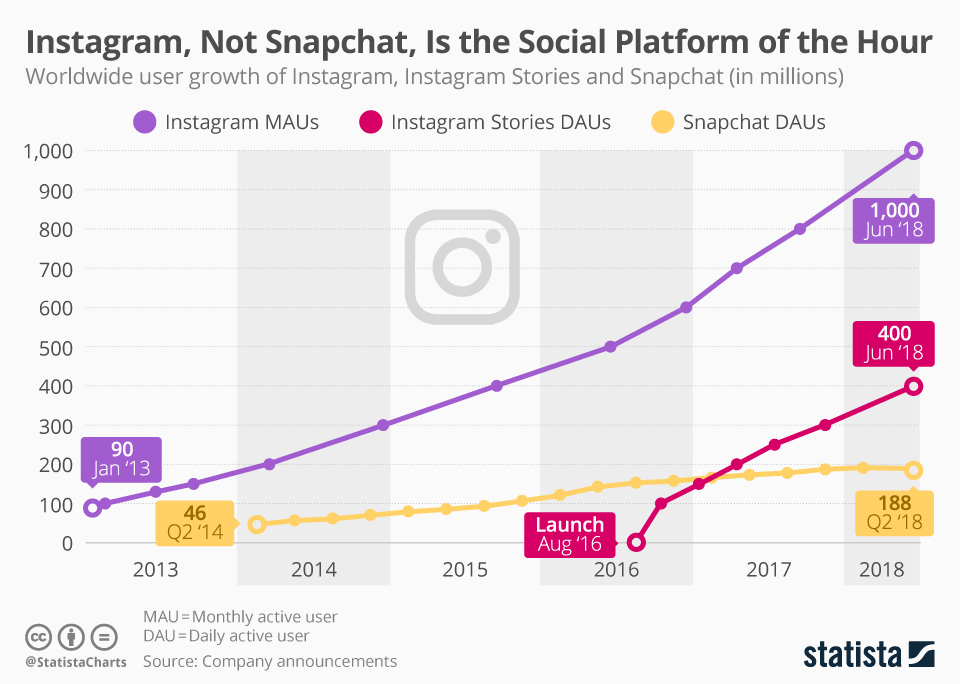
There’s a certain freedom from content that can only be viewed once, or may only exist for a certain period of time. The content can be more simple, organic, spontaneous, and fun. It creates urgency, and on interaction, the right content delivers a rewarding experience for viewers, as well as allowing a response and a chance to communicate, making people feel seen and heard.
One of the more interesting chances for authenticity has come from brands breaking down walls to take a stand on political and social issues. While perceived as risky, consumer opinion is changing fast. Within six months between two major studies, the majority of consumers had shifted towards wanting brands to take a stand. Another study found that 65% of millennials said they would not buy from brands who stay silent on social issues.
This doesn’t mean needing to choose a polarising position, but silence from both brands and their executives is becoming less viable. In 2019, brands understanding their position, and communicating beliefs effectively play a role in relevance. Leaders include the likes of the NBA, Patagonia, Airbnb, and Lyft, where consumers trust that brand to make the right decisions for them across social or political issues, and therefore in the way they treat their employees, customers, the environment, and their corporate responsibility.

Conclusion
As always, looking towards the future (without a crystal ball 🔮) is a challenge. However, these trends are based on factors we’ve seen, technologies that are coming, and trends that showed green shoots in 2018 are ready to bear fruit for marketers. Within 2019 itself, we’re likely to see new ideas both rise up and peter out quickly.
But nothing about social media has changed from the core philosophies of authenticity, engagement, connection, and listening. The format for how that is achieved is what is changing.
Not everything here will suit your team of thinkers and creatives, not everything will show instant results. But knowing, planning, understanding what fits your brand and your audience best is where we pass the torch across to you!







